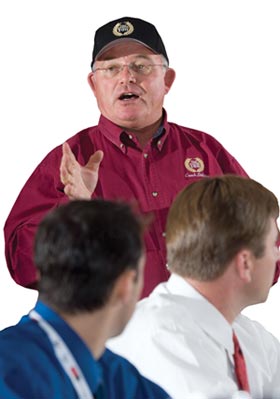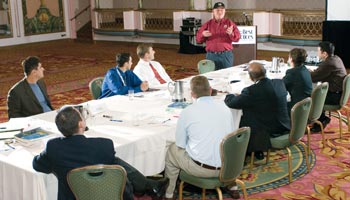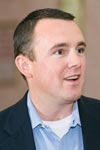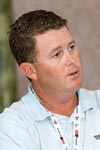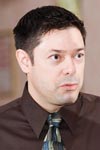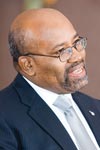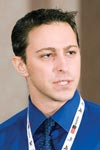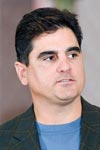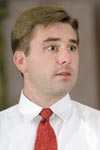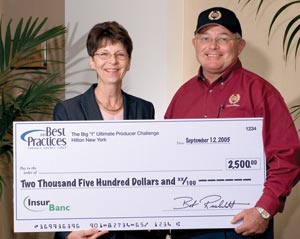|
You're fired! Nine agents face The Ultimate Producer Challenge By Dennis H. Pillsbury
The room was hushed as the nine finalists walked in, wondering what to expect. The silence was quickly dispersed as sales guru Roger Sitkins started off by explaining why he was not wearing a Donald Trump wig in his role as host of this misbegotten offspring of “The Apprentice.” “I looked even worse in the wig than The Donald,” he quipped. And so it began. Each of the nine finalists had applied to be part of this eight-hour undertaking by submitting a brief essay on why they should be considered for designation as The Ultimate Producer. (For a list of the finalists, see the sidebar on page 60.) The Ultimate Producer Challenge took place on the final day of the Independent Insurance Agents & Brokers of America (IIABA) Annual Convention held in New York City. The final two were on stage at the closing general session prior to the featured speaker, Rudolph Giuliani. The winner was presented with a check for $2,500 and recognition as The Ultimate Producer, while the runner-up was “fired” before what turned out to be a standing-room-only crowd of more than 1,000 people. So the stakes were high. The beginning session began at 8 a.m. sharp with a threat of push-ups hanging over any stragglers. It ended at noon. The breaks, the length of which were determined and announced by Roger, occurred approximately every hour. They were started and ended by a coach’s whistle with the same stricture regarding timeliness. With one exception, that being myself, the morning session was closed and was an educational session where the nine participants learned and practiced what was expected of them in the afternoon session. At the session following lunch, the contestants would have to face the public and The Roger, the Ultimate Arbiter of The Ultimate Producer Challenge, and could be fired. WIN
The morning session began with Roger presenting a WIN (What Is Normal) list that involved strategies and skills that each of the nine were supposed to make normal in their selling careers. “Our real goal here is to transform,” Roger said. “I want each of you to look at me as one of your large clients or prospects. You have to be externally focused on your clients and prospects, to see things through their eyes, so that you can be proactive, rather than reactive.” The objective is to become each client’s trusted advisor. To determine if an agent has been successful in this endeavor is quite simple. If the client calls the agent before he makes a significant change in the way he or she is doing business, then the agent is a trusted advisor. If the agent finds out after the fact, then the agent is a vendor. Roger suggested several other areas where an agent could transform from primarily reactive to proactive. “Have trusted advisor lunches where you invite an important client to come in and discuss anything and everything. Determine exactly what you make from a client and spend 5% of those revenues on that client. And do that in a meaningful way. Talk to your clients and remember what their likes and dislikes are. When you get them a gift on their birthday or for no reason at all, make it something they will remember. If they’re avid football fans and you can get tickets for a game, that might be the memorable gift. But, make certain you know whom the client’s favorite team is. You don’t want to be sending an avid Gator fan to a Hurricane game.”
Pareto’s Principle It may sound a lot like what one learned in kindergarten. Well, that isn’t true of the next segment—Pareto’s Principle—although it is relatively simple. It’s the 80/20 rule. While it appears simple, the application of the rule can be difficult and takes a change in mindset for many people. The first application of the rule applies to the personal transformation that agents need to undergo in order to become ultimate producers. Most agents are spending 80% of their time reacting to situations. Ultimate producers spend 80% of their time proactively. So how is an agent going to become more proactive when that agent is taking care of a bunch of clients? That’s where the second use of Pareto’s Principle comes into play. The agent needs to pare down the number of clients to “the vital few.” It sounds counterintuitive. But, in order to become an ultimate producer, an agent needs to grow by reducing the number of clients in his or her book. “Agents need to analyze their book of business with the 80/20 rule in mind,” Roger advised. “On average, the bottom 25% only provides 2% of an agent’s revenue; the bottom 50% only provides 5%. These are the clients who need to be traded to another person in the agency who loves working with smaller accounts. We don’t want the independent agency system to lose these clients. But we do want them to be handled by a person who is best able to do the job. Then you can concentrate on increasing your revenue by concentrating on a select group of clients of a certain revenue size. “Consider the fact that the top 2% of clients at the average agency provide 31% of the agency’s revenue and you can see quite dramatically who needs to be treated best, so they can be retained.” Roger continued, “You need to decide what your minimum account size will be and what your target account size will be and trade all the rest of your accounts. It all comes down to ROT—Return On Time. There are only 168 hours in a week. If you’re spending half of that time working and most of that time reacting to clients because you have so many, then you’ll never be able to raise the bar and increase your revenue. And that’s what this is all about—raising the bar.” The four R’s He then moved on to the need for a focus on the four R’s—results, relationships, retention and referrals. “You need to make certain that you focus on getting results, not just activity.” He pointed out that this goes back to return on time and making certain that the majority of your time is spent proactively working toward the goal of selecting clients rather than just accepting them. To accomplish positive results, ultimate producers need to develop strong relationships at five levels. 1. Relationships with clients. “You need to be advocates for your clients and meet and exceed their expectations,” Roger advised. “To accomplish this, you need to really get to know your clients. Find out everything you can about them so you’re always in a position to under-promise and over-deliver.” 2. Relationships with prospects. “These are your future clients. You need to identify 20 targets for the year.” 3. Relationships with companies. “You can’t help your clients if your insurance companies won’t write the business. Make sure you acknowledge those underwriters with whom you work. Send them a thank you note or gift when they do something special.” 4. Relationships with employees. “You need a team of people behind you for this to work. Make certain you keep them in the loop by briefing and debriefing them after client meetings. And make certain you thank them for their help.” 5. Relations with your center of influence network. “These are the people who will be recommending you to future clients. Make certain that you provide them the same courtesy so there are deposits as well as withdrawals from this relationship.” Retention clearly is an important goal, especially for ultimate producers who are working with clients who account for a significant amount of revenue for them and for their agency. “You must turn every one of these clients into a full-time client,” Roger said. “That means that you should be the only agent with whom they ever talk. All their insurance coverages should be with you. Make this an ongoing relationship where you have regular contact with these important clients so that the renewal is just another event in the ongoing relationship, not a moment to reevaluate coverage. That should be done on an ongoing basis. Remember, your goal is to be the trusted advisor who gets the call before something happens, not after.”
The final goal is to grow solely through referrals. “You want enough ROPE—Referral Only Production Explosion—to achieve your targeted annual revenue,” Roger said. “That means that you need to have a referral mindset and actually ask your clients for referrals. Too many agents are afraid to ask, but you shouldn’t be. If you’ve done a great job for the client, then he or she should be happy to recommend you and let you use their names.” The four-hour morning session also gave each of the contestants an opportunity to develop a unique message that could be presented to prospective clients and practice that message in front of their peers without the threat of being fired hanging over their respective heads. As each presented, Roger continued to provide advice on ways to refine their message so they could continue to hold the attention of prospects. For example, you don’t tell people you sell insurance unless you want them to walk away to the next conversation. You don’t emphasize that you can save them money on their coverage, because you’re just attracting shoppers who will move on when another agent can save them money. The afternoon session was more intense as the prospect of being fired fueled the competitive juices of each contestant. And this time, they were in front of an audience. Each had to present their unique message to a prospective client while the others waited out in the hall. The order of presentation was randomized. Then one was fired and they were down to eight. Other presentations involved asking for referrals and explaining why they should be considered The Ultimate Producer. And after each set of presentations, more were fired. Throughout the session, Roger emphasized that every participant was a winner because they all were learning how to become better producers. The greatest danger, Roger warned, was airport amnesia where you forget everything you learned and go back to business as usual. That’s why each participant created a list of tasks that they wanted to make normal—their WIN list. For seven of the contestants, the events of the day ended unhappily until they considered that one of the final two—Diane Durnin or Roosevelt Haywood III—would be fired in front of a huge crowd. Roosevelt was dismissed from the stage and left with classy aplomb, and Diane Durnin was named the winner of The Ultimate Producer Challenge. * |
|||||||||||||||||||||||||||
| |||||||||||||||||||||||||||



